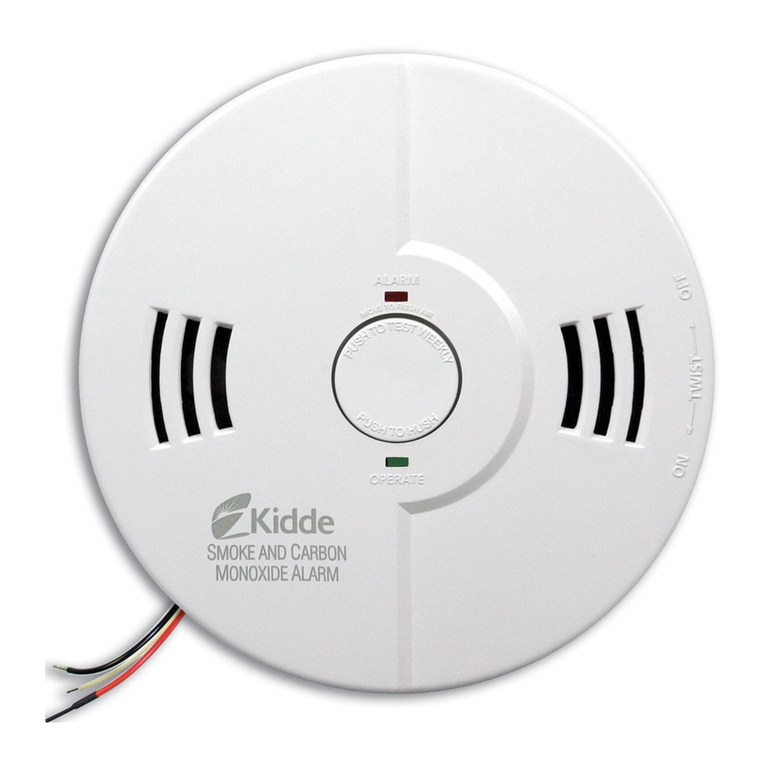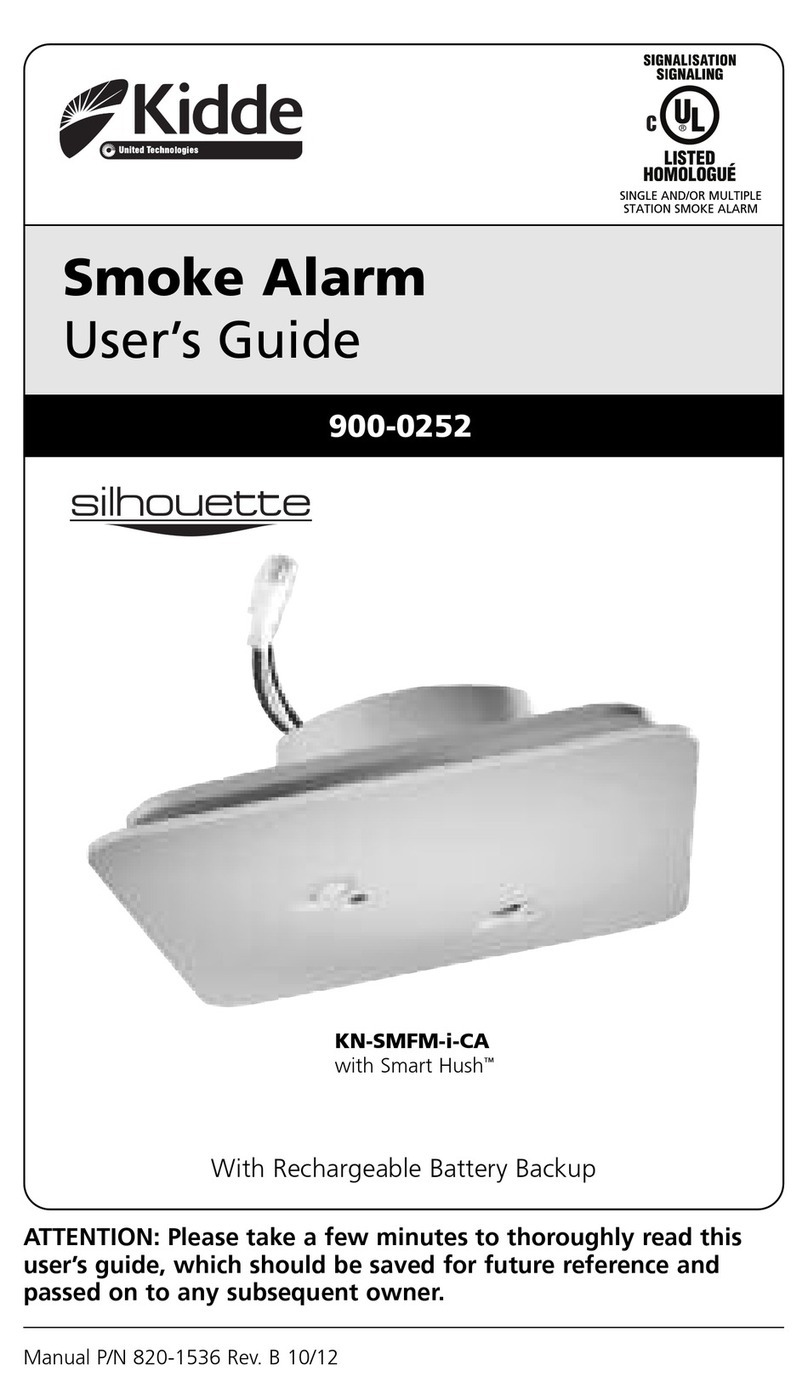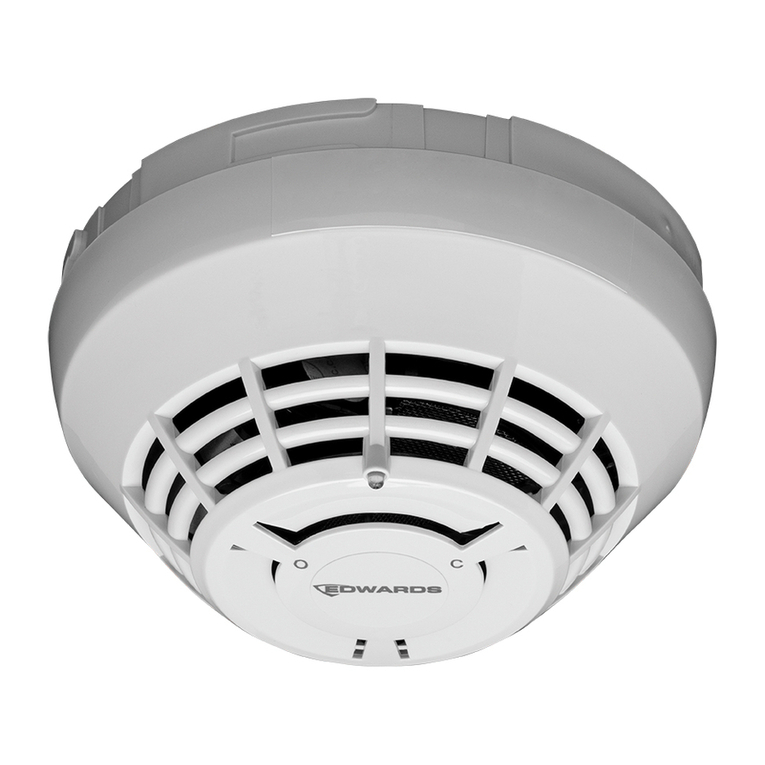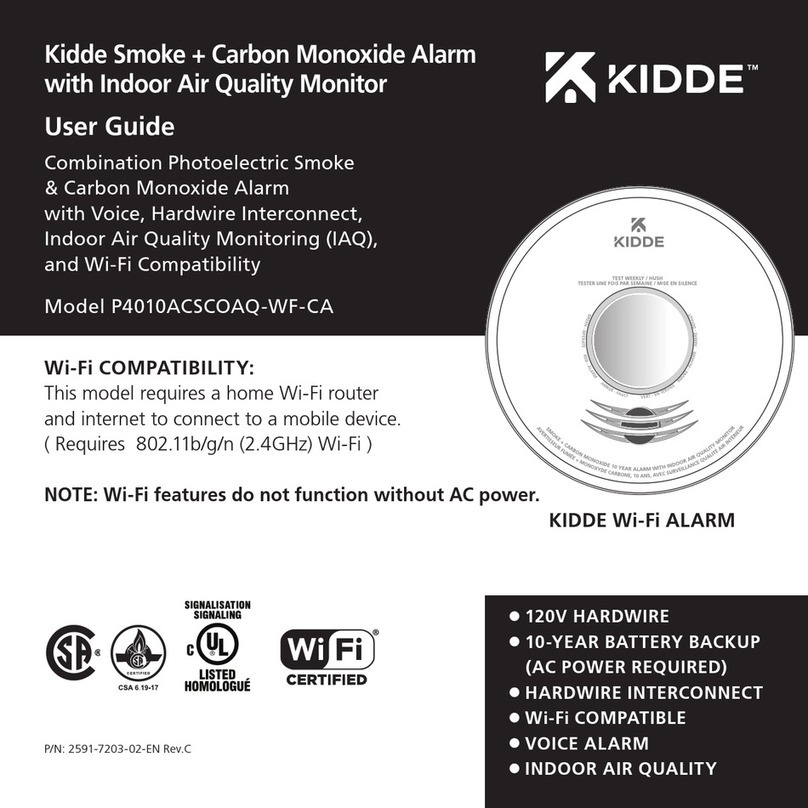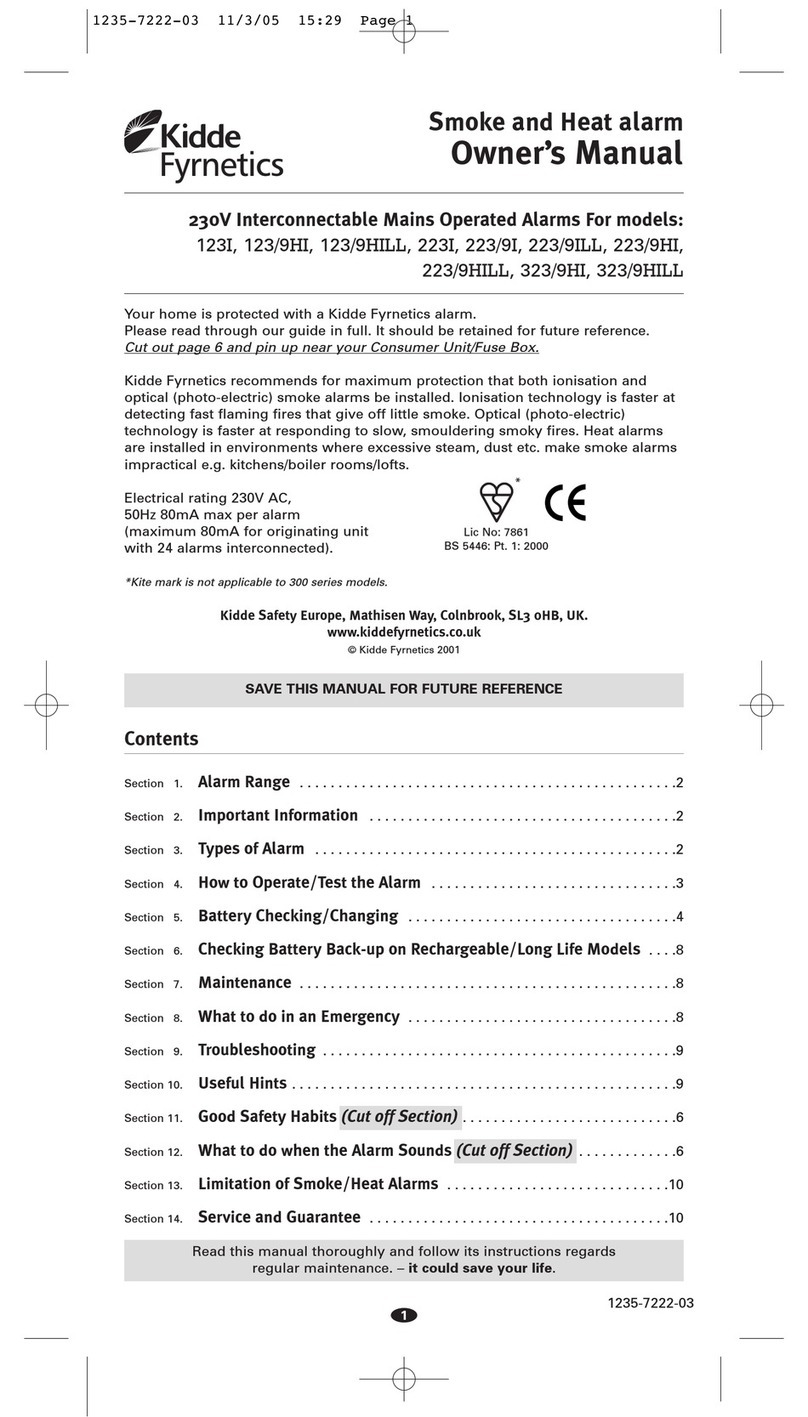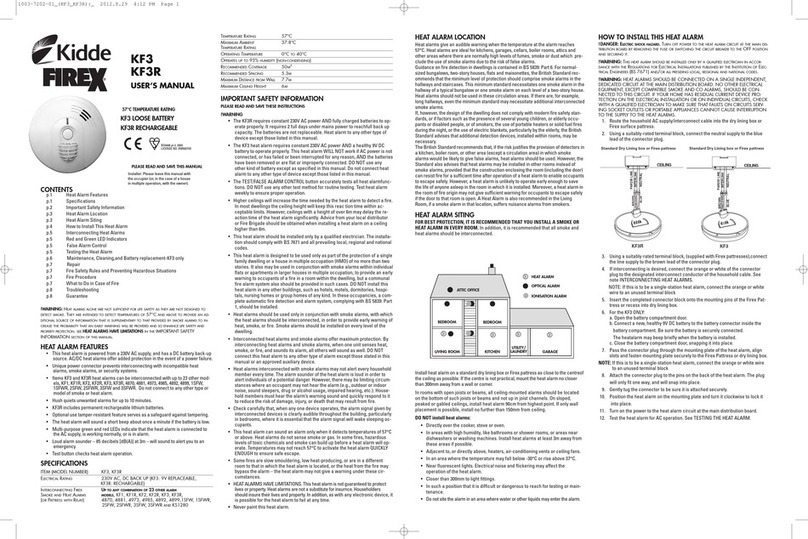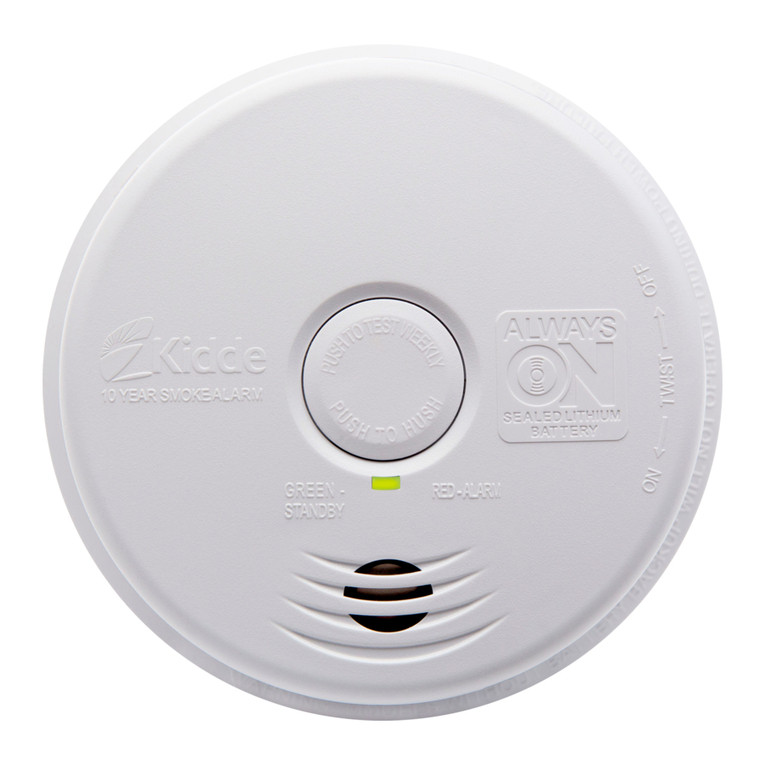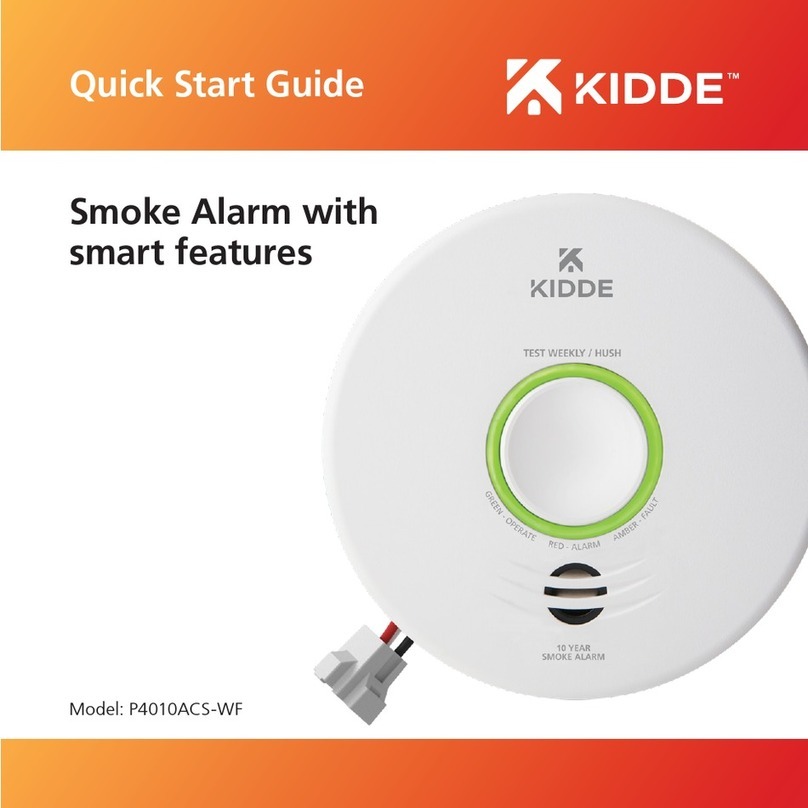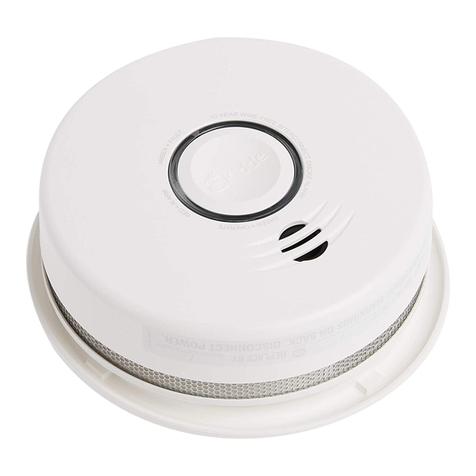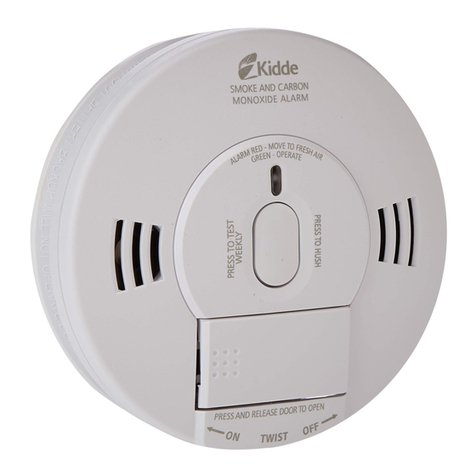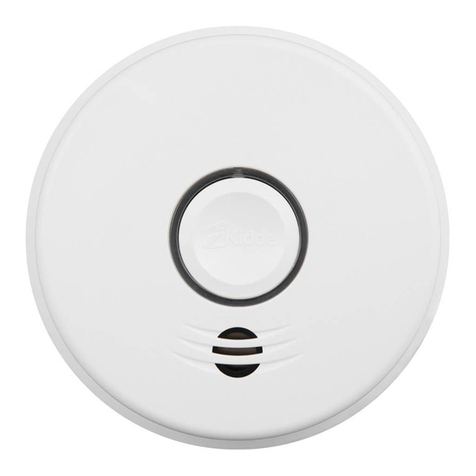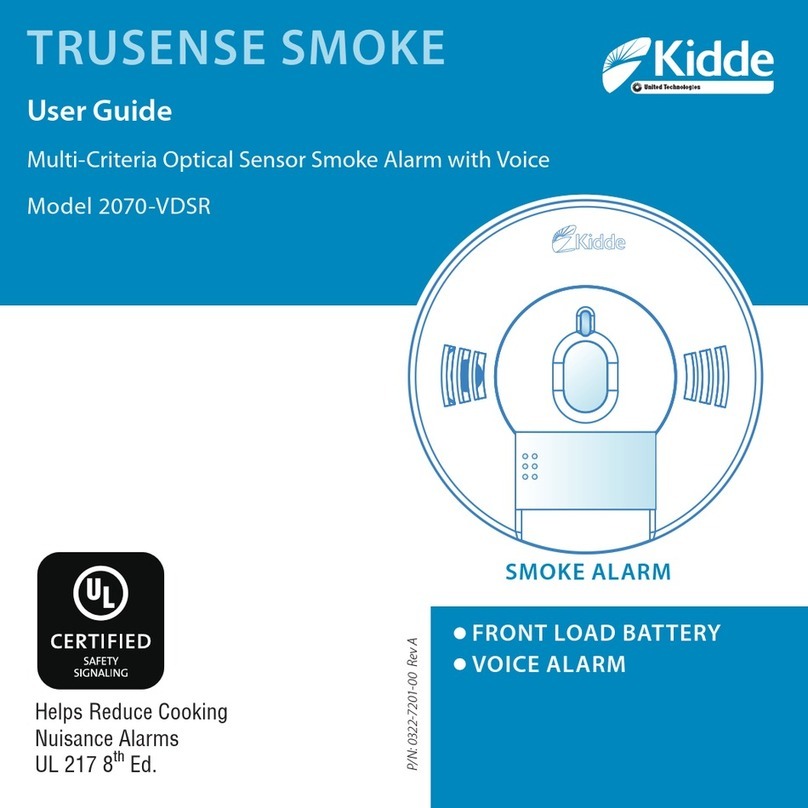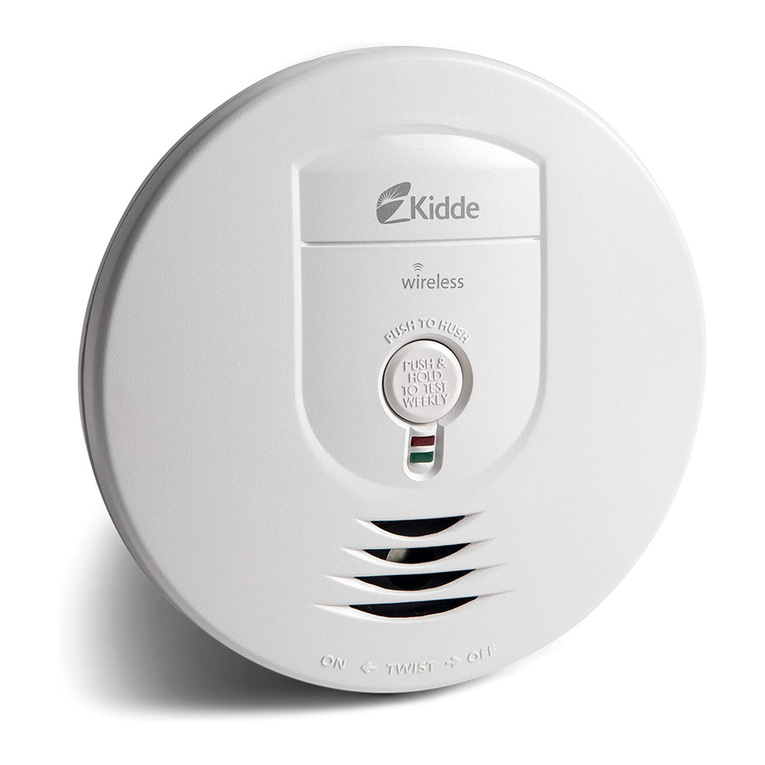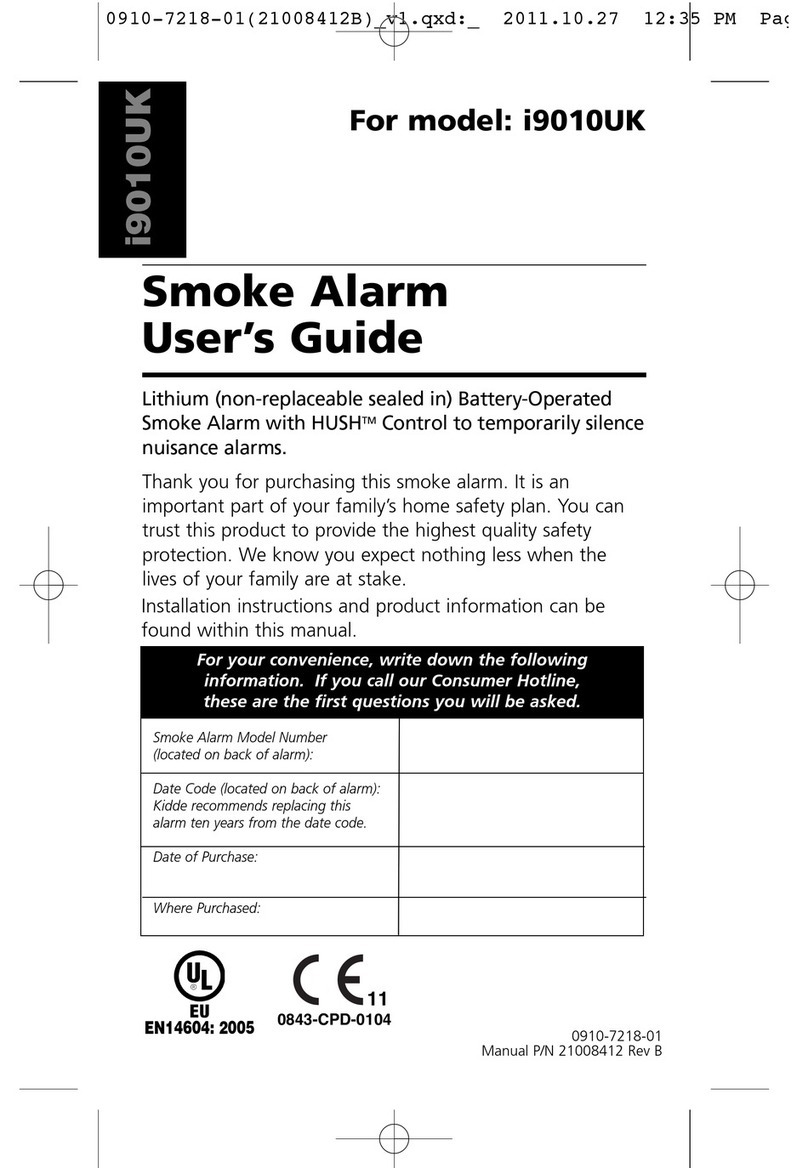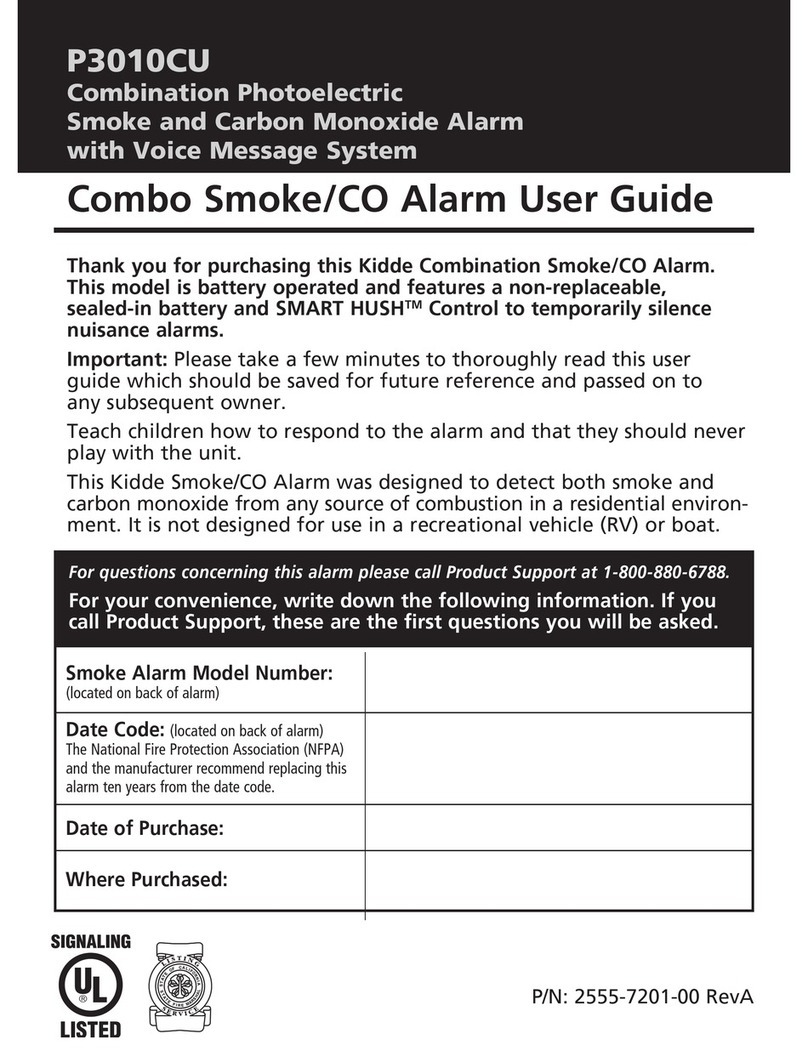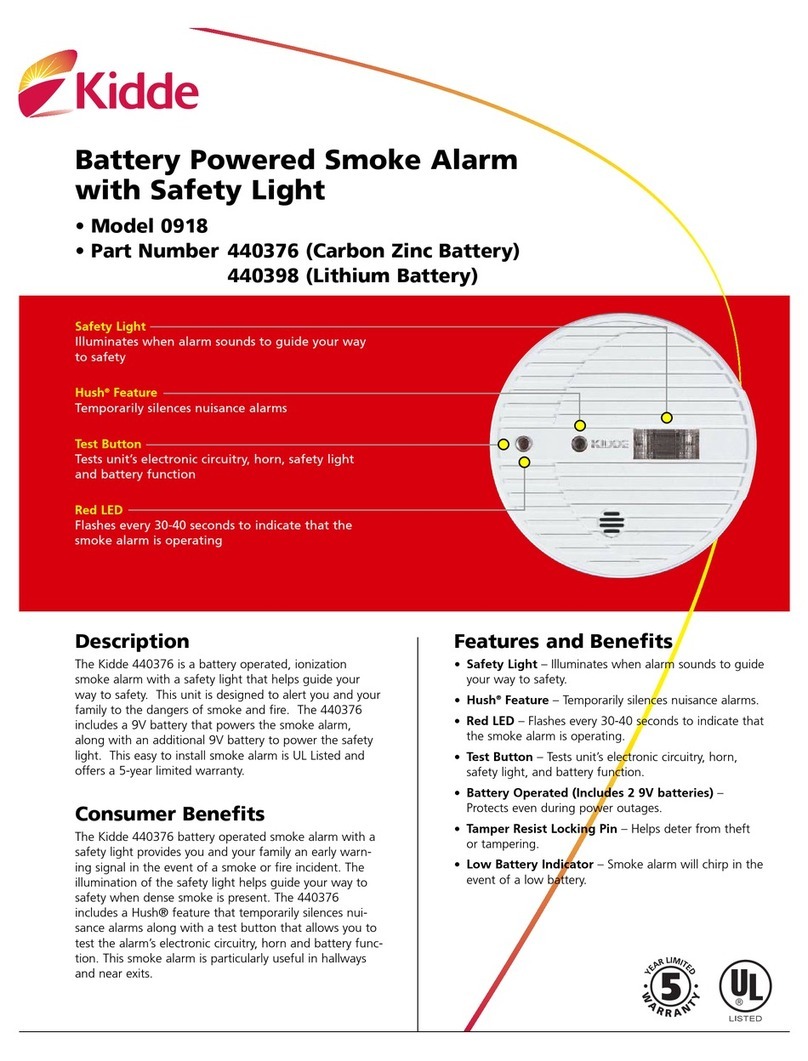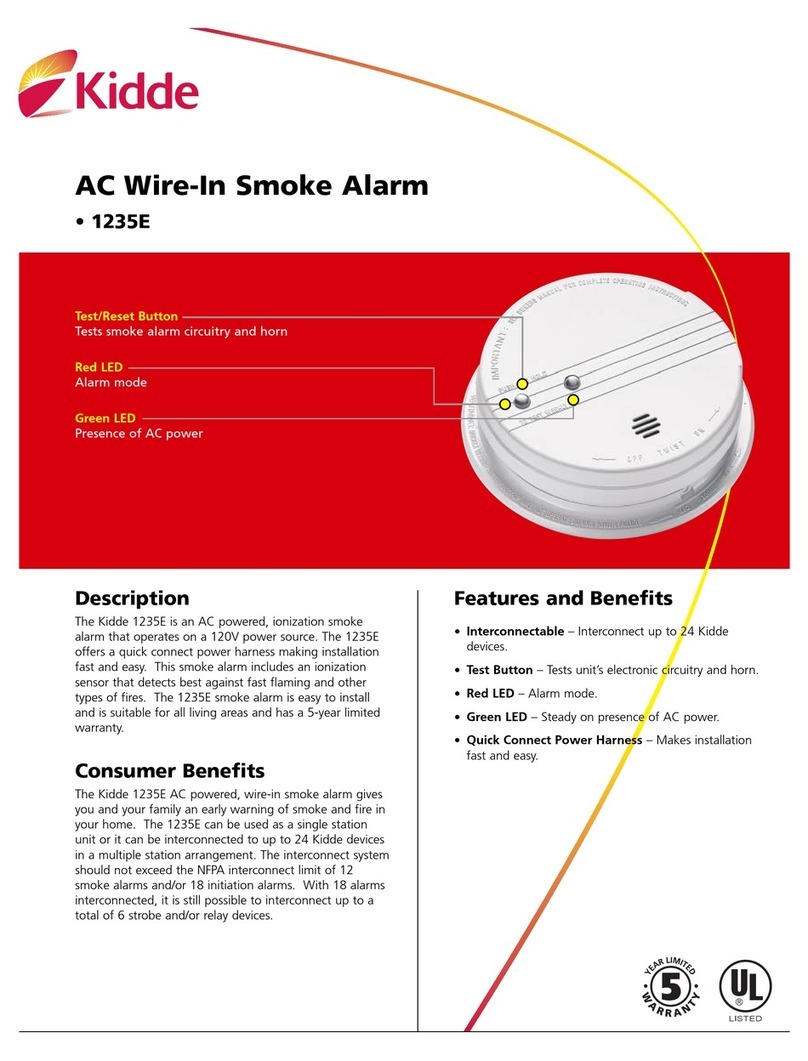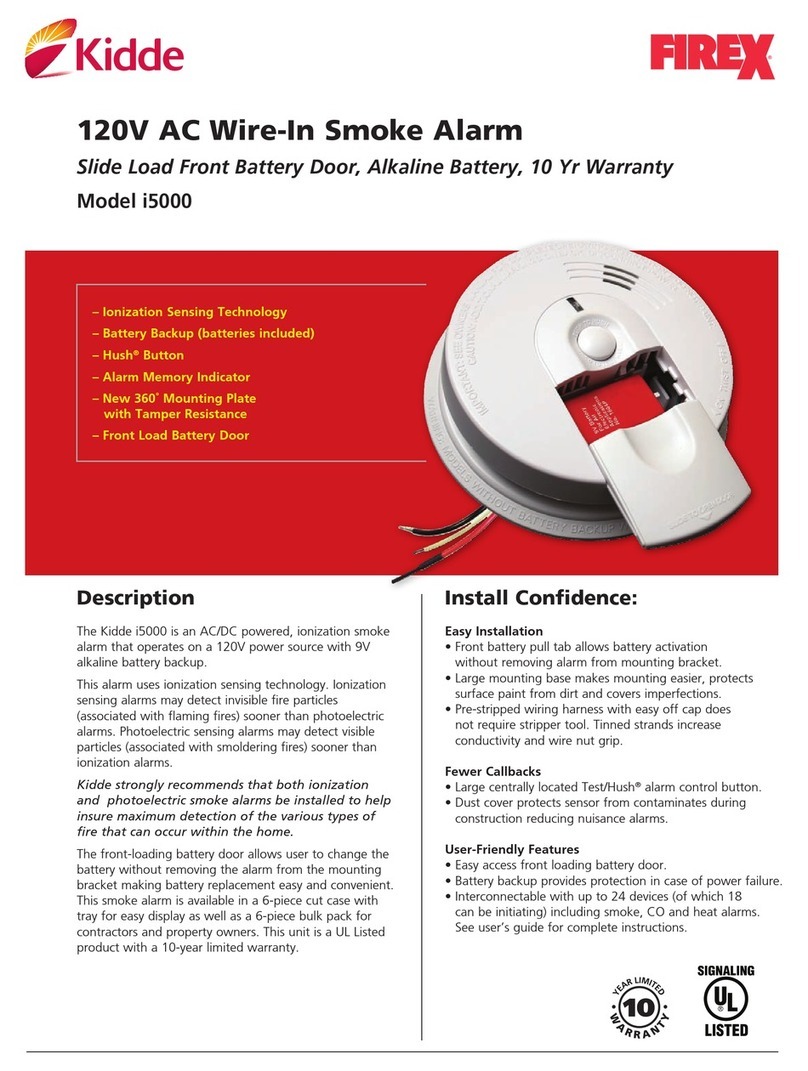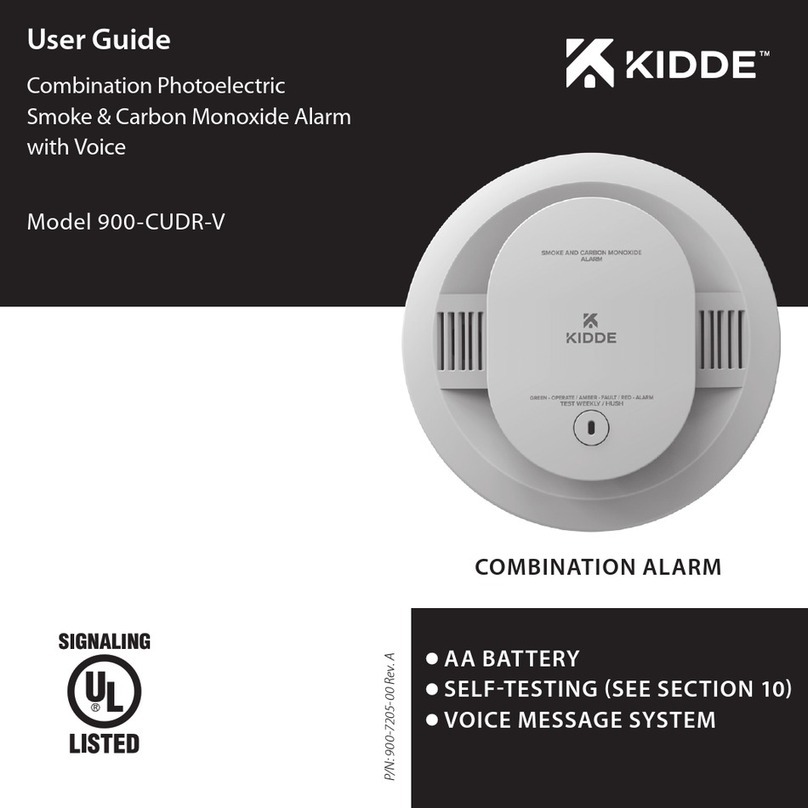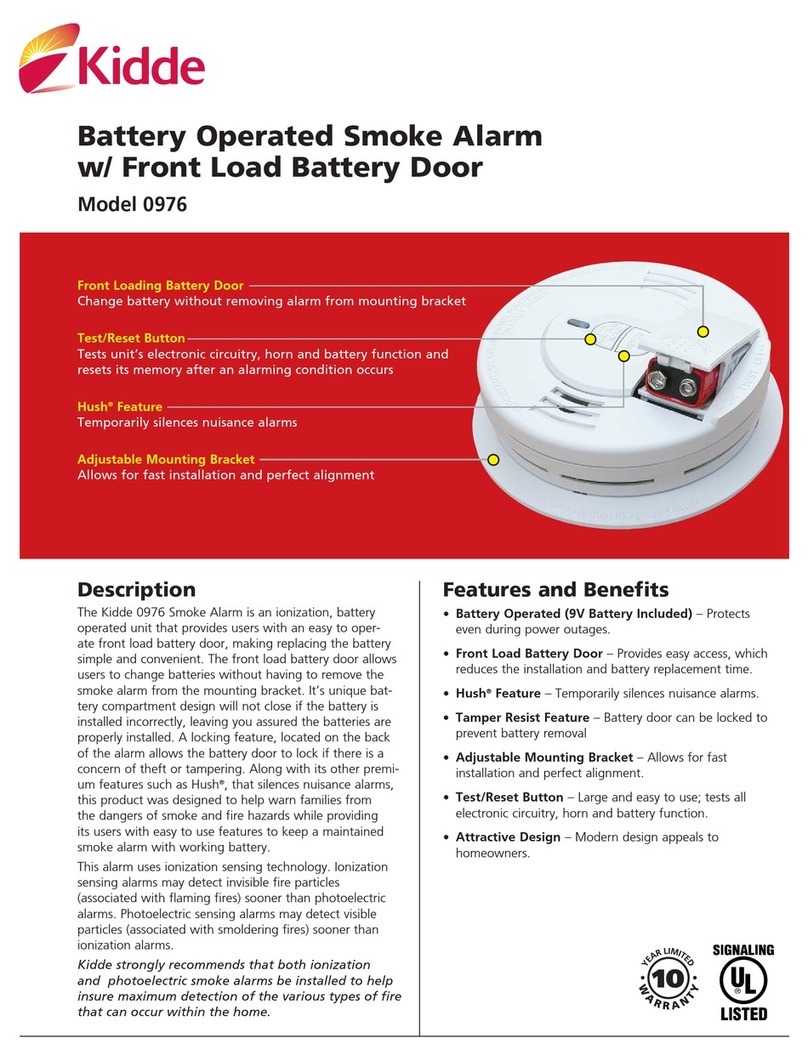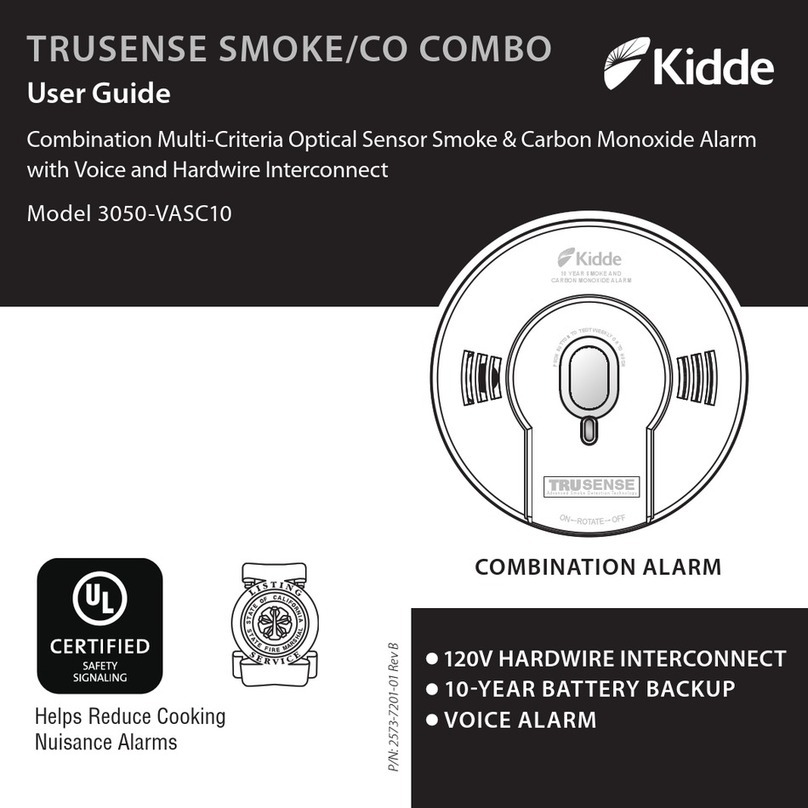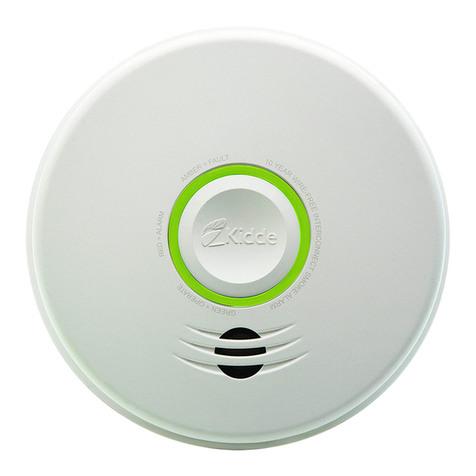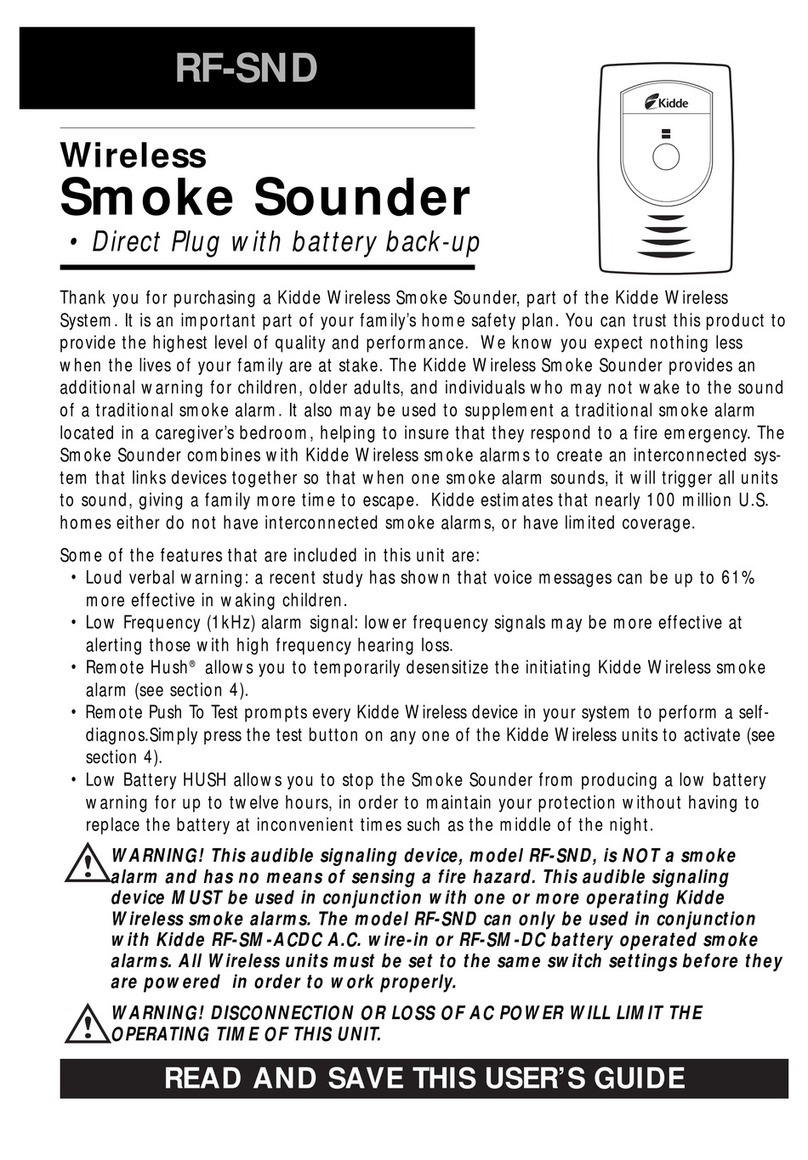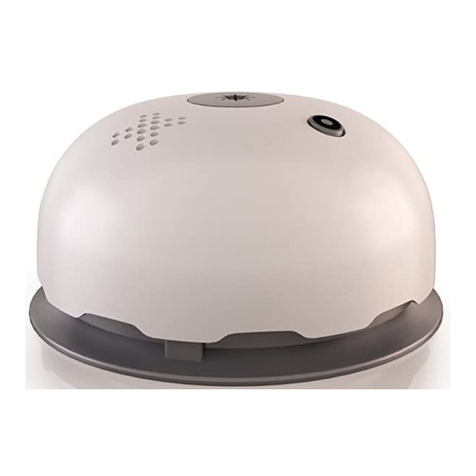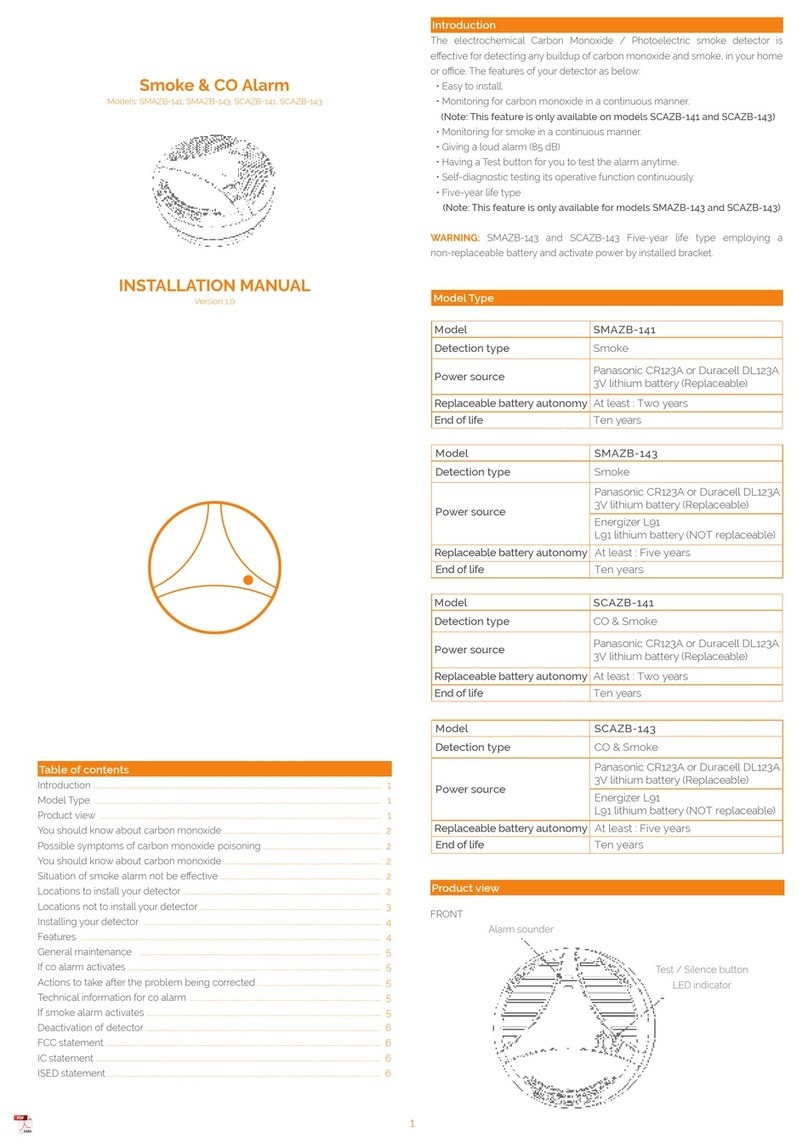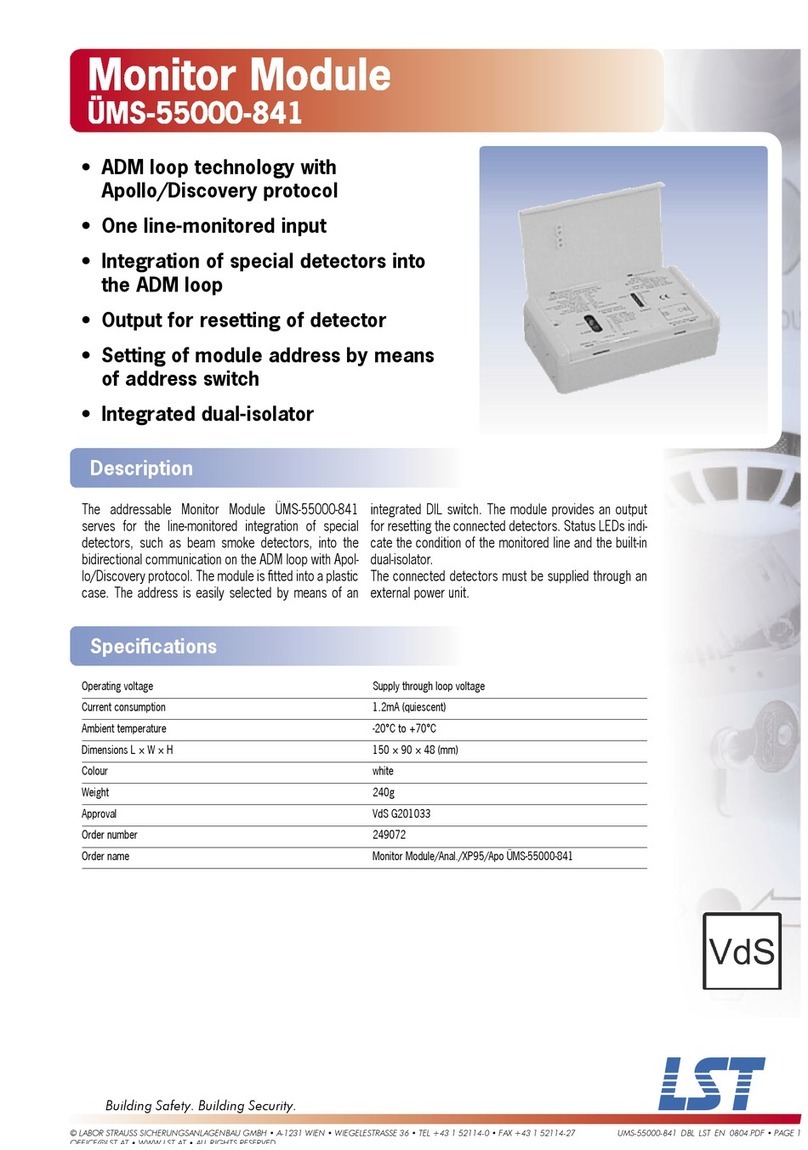g is complete.
arm until the air is
g the alarm circuit
ndition, such as
g the “HUSH” but-
mmediately and the
e alarm is in a
roximately 10
ed repeatedly
et button on the
D SOUND A
URCE OF THE
ED is located
at the smoke
s into alarm,
e rapid flashing
ed.
rm is in Hush
p. Replace the
onents in the
indicator light. (If
information.)
um of 5 seconds.
f no alarm
o test your alarm,
ure which
pushed. This
t was last tested.
memory sound is
gain to enter the
d coming from
Section 12).
5.NUISANCE ALARMS
Smoke alarms are designed to minimize nuisance alarms. Cigarette smoke will not normally set off the
alarm, unless the smoke is blown directly into the alarm. Combustion particles from cooking may set off
the alarm if the alarm is located close to the cooking area. Large quantities of combustible particles are
generated from spills or when broiling. Using the fan on a cooker which vents to the outside (non-recir-
culating type) will also help remove these combustible products from the kitchen.
If the alarm does sound, check for fires first. If a fire is discovered, get out and call the fire brigade. If
no fire is present, check to see if one of the reasons listed in Section 2 may have caused the alarm.
The model PI 9000UK has a “HUSH” control that is extremely useful in a kitchen area or other areas
prone to nuisance alarms. For more information refer to Section 4, OPERATION AND TESTING.
6.MAINTENANCE
ALARM REMOVAL
IF TAMPER RESIST FEATURE HAS BEEN ACTIVATED, REFER TO TAMPER RESIST FEATURE
DESCRIPTION IN SECTION 3 FOR REMOVAL INSTRUCTIONS.
To replace the battery, remove the alarm from the trim ring by rotating the alarm in the direction of the
“OFF” arrow on the cover.
BATTERY INSTALLATION AND REMOVAL
To replace or install the batteries you must first remove the alarm from the trim ring by following the
ALARM REMOVAL instructions at the beginning of this section. After alarm has been removed , you can
open the battery door and install or replace the battery. Battery installation instructions are provided on
the inside of the battery door.
When installing the battery, press the battery reminder finger down into the battery compartment and
install the battery (see Section 3, Figure 3).
CAUTION! IF THE BATTERY REMINDER FINGER IS NOT HELD DOWN IN THE BATTERY
COMPARTMENT BY THE BATTERY, THE BATTERY DOOR WILL NOT CLOSE AND THE ALARM
WILL NOT ATTACH TO THE TRIM RING.
This smoke alarm uses a 9V alkaline battery (a lithium battery may also be used). A fresh alkaline
battery should last for one year under normal operating conditions.
This alarm has a low battery monitor circuit which will cause the alarm to “chirp’” approximately every
30 - 40 seconds for a minimum of seven (7) days when the battery gets low. Replace the battery when
this condition occurs.
USE ONLY THE FOLLOWING 9 VOLT BATTERIES FOR SMOKE ALARM REPLACEMENT.
Alkaline type EVEREADY 522; DURACELL MX 1604, MN1604; GOLD PEAK 1604A
Lithium type ULTRALIFE U9VL
After installing or changing the battery, reinstall your alarm. Test your alarm by using the test button.
NOTE: REGULAR TESTING IS RECOMMENDED.
WARNING! USE ONLY THE BATTERIES SPECIFIED. USE OF DIFFERENT BATTERIES MAY HAVE A
DETRIMENTAL EFFECT ON THE SMOKE ALARM.
CLEANING YOUR ALARM: YOUR ALARM SHOULD BE CLEANED AT LEAST ONCE A YEAR
To clean your alarm, remove it from the mounting bracket as outlined in the beginning of this section.
You can clean your alarm by using compressed air or a vacuum cleaner hose to blow or suck air
through the openings around the perimeter of the alarm. The outside of the alarm can be wiped with a
damp cloth. If cleaning does not restore the alarm to normal operation the alarm should be replaced.
After cleaning, reinstall your alarm. Test your alarm by using the test button.
7.LIMITATIONS OF SMOKE ALARMS
WARNING: PLEASE READ CAREFULLY AND THOROUGHLY
•NFPA 72 states: Life safety from fire in residential occupancies is based primarily on early notification
to occupants of the need to escape, followed by the appropriate egress actions by those occu-
pants. Fire warning systems for dwelling units are capable of protecting about half of the occupants
in potentially fatal fires. Victims are often intimate with the fire, too old or young, or physically or
mentally impaired such that they cannot escape even when warned early enough that escape
should be possible. For these people, other strategies such as protection-in-place or assisted
escape or rescue are necessary.
• Smoke alarms are devices that can provide early warning of possible fires at a reasonable cost;
however, alarms have sensing limitations. Ionization type alarms offer a broad range of fire sensing
capabilities but are better at detecting fast flaming fires than slow smoldering fires. Photoelectric
alarms sense smoldering fires better than flaming fires. Home fires develop in different ways and are
often unpredictable. Neither type of alarm (photoelectric or ionization) is always best, and a
given alarm may not always provide warning of a fire.
• A battery powered alarm must have a battery of the specified type, in good condition and installed
properly.
• A.C. powered alarms will not operate if the A.C. power has been cut off, such as by an electrical fire
or an open fuse.
• Smoke alarms must be tested regularly to make sure the batteries and the alarm circuits are in good
operating condition.
• Smoke alarms cannot provide an alarm if smoke does not reach the alarm. Therefore, smoke
alarms may not sense fires starting in chimneys, walls, on roofs, on the other side of a closed door
or on a different floor.
• If the alarm is located outside the bedroom or on a different floor, it may not wake up a heavy
sleeper.
• The use of alcohol or drugs may also impair one’s ability to hear the smoke alarm. For maximum
protection, a smoke alarm should be installed in each sleeping area on every level of a home.
• Although smoke alarms can help save lives by providing an early warning of a fire, they are not a
substitute for an insurance policy. Home owners and renters should have adequate insurance to
protect their lives and property.
8.GOOD SAFETY HABITS
DEVELOP AND PRACTICE A PLAN OF ESCAPE
• Make a floor plan indicating all doors and windows and at least two (2) escape routes from each
room. Second storey windows may need a rope or escape ladder.
• Have a family meeting and discuss your escape plan, showing everyone what to do in case of fire.
• Determine a place outside your home where you all can meet if a fire occurs.
• Familiarize everyone with the sound of the smoke alarm and train them to leave your home when
they hear it.
• Practice a fire drill at least every six months including fire drilling at night. Ensure that small children
hear the alarm and wake when it sounds. They must wake up in order to execte the escape plan.
Practice allows all occupants to test your plan before an emergency. You may not be able to reach
your children. It is important they know what to do.
• Install and maintain fire extinguishers on every level of the home and in the kitchen, basement and
garage. Know how to use a fire extinguisher prior to an emergency.
WHAT TO DO WHEN THE ALARM SOUNDS
• Leave immediately by your escape plan. Every second counts, so don’t waste time getting dressed
or picking up valuables.
• In leaving, don’t open any inside door without first feeling its surface. If hot, or if you see smoke
seeping through cracks, don’t open that door! Instead, use your alternate exit. If the inside of the
door is cool, place your shoulder against it, open it slightly and be ready to slam it shut if heat and
smoke rush in.
• Stay close to the floor if the air is smoky. Breathe shallowly through a cloth, wet if possible.
• Once outside, go to your selected meeting place and make sure everyone is there.
• Call the fire brigade from your neighbour’s home - not from yours!
• Don’t return to your home until the fire officials say that it is all right to do so.
There are situations where a smoke alarm may not be effective to protect against fire as stated in the NFPA
Standard 72. For instance:
a) smoking in bed
b) leaving children home alone
c) cleaning with flammable liquids, such as gasoline
Further information on fire safety can be obtained in a pamphlet titled “IN A FIRE SECONDS
COUNT” published by the NFPA, Batterymarch Park, Quincy, MA 02269
9.NRC INFORMATION
The ionization portion of this smoke alarm uses a very small amount of a radioactive element in the
sensing chamber to enable detection of visible and invisible combustion products. The radioactive ele-
ment is safely contained in the chamber and requires no adjustments or maintenance. This smoke
alarm meets or exceeds all government standards. It is manufactured and distributed under license
from the U.S. Nuclear Regulatory Commission.
10. NFPA REQUIRED PROTECTION
The National Fire Protection Association’s Standard 72 provides the following information:
Smoke alarms shall be installed outside each separate sleeping area in the immediate vicinity of the
bedrooms and on each additional story of the family living unit, including basements and excluding
crawl spaces and unfinished attics. In new construction, a smoke alarm also shall be installed in each
sleeping room.
Smoke Detection - Are More Smoke Alarms Desirable? The required number of smoke alarms might
not provide reliable early warning protection for those areas separated by a door from the areas pro-
tected by the required smoke alarms. For this reason, it is recommended that the householder consid-
er the use of additional smoke alarms for those areas for increased protection. The additional areas
include the basement, bedrooms, dining room, furnace room, utility room, and hallways not protected
by the required smoke alarms. The installation of the smoke alarms in the kitchen, attic (finished or
unfinished), or garage is normally not recommended, as these locations occasionally experience condi-
tions that can result in improper operation.
This equipment should be installed in accordance with the National Fire Protection Association’s
Standard 72 (NFPA, Batterymarch Park, Quincy, MA 02269).
NOTIFY YOUR LOCAL FIRE DEPARTMENT AND INSURANCE COMPANY OF YOUR SMOKE ALARM
INSTALLATION.
11. CAUTION (AS REQUIRED BY THE CALIFORNIA STATE
FIRE MARSHAL FOR UNITED STATES ONLY)
“Early warning fire detection is best achieved by the installation of fire detection equipment in all rooms
and areas of the household as follows: A smoke alarm installed in each separate sleeping area (in the
vicinity of, but outside of the bedrooms), and heat or smoke detectors in the living rooms, dining
rooms, bedrooms, kitchens, hallways, attics, furnace rooms, closets, utility and storage rooms, base-
ments and attached garages.”
12. SERVICE AND WARRANTY
If after reviewing this manual you feel that your smoke alarm is defective in any way, do not tamper with
the unit. Please contact: Kidde Safety Europe, Mathisen Way, Colnbrook, SL3 oHB, UK.
GUARANTEE
We, Kidde Safety Europe Limited, guarantee the enclosed smoke alarm for a period of five years
from the date on which you purchased it.
CONDITIONS OF GUARANTEE
We will repair or replace the smoke alarm (or any part of it), free of charge, if any defect which is the
result of faulty materials, workmanship or design arises within five years from the date on which you
purchased the smoke alarm. This guarantee excludes defects which are the result of :
(a) wilful or accidental damage;
(b) neglect;
(c) use or maintenance otherwise than in accordance with these instructions;
(d) alterations or modifications to or repair of the smoke alarm by anyone other than us; or
(e) inadequate AC or DC electrical power.
This guarantee does not cover batteries.
This guarantee applies only to individuals situated in the United Kingdom. This guarantee is non-
transferrable.
MAKING A CLAIM UNDER THIS GUARANTEE
If you need to make a claim under this guarantee, you must contact us within 14 days from the
date on which you discover the defect. Please return the smoke alarm to us, together with proof of
the date on which you purchased it, postage and return postage prepaid, to Warranty Service
Department, Kidde Safety Europe Limited. Mathisen Way, Colnbrook, SL3 OHB.
We will then send you either a repaired or replacement smoke alarm.
THIS GUARANTEE DOES NOT AFFECT YOUR STATUTORY RIGHTS.
QUESTIONS OR FOR MORE INFORMATION
Call our Consumer Hotline at
01753 685148
or contact us at our website at
www.kiddesafetyeurope.co.uk
Mathisen Way, Colnbrook,
SL3 oHB, UK.
